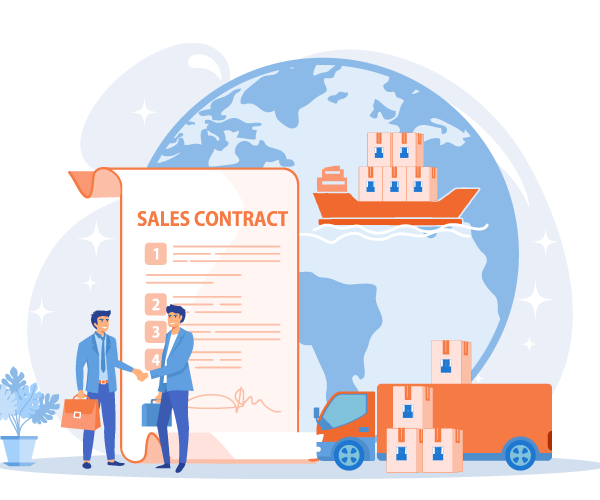Export Service
10+ Plus
Countries

Export Strategy
We can identify a business strategy for entering and expanding into new export markets. Highlighting the legal requirements, documentation requirements, product registration / conformity obligations and tax regulations. The strategy would embrace alternative processes to complete customs declarations and pay taxes / duties without registering your company within the export countries.
- Identify Target Markets: Begin by researching and identifying the most suitable international markets for your products or services. Consider factors such as market size, growth potential, competition, and cultural nuances.
- Compliance and Certification: Ensure that your products meet all necessary quality standards, certifications, and regulatory requirements in the target market.
- E-commerce and Digital Presence: Leverage e-commerce platforms and digital marketing strategies to reach a global audience directly.

Export Documents
Having the correct documentation is vital when exporting, as inappropriate or overlooked documentation can lead to shipping delays, increased costs and business risks, such as cancelled international commercial activities.
- A detailed invoice that specifies the products, their quantities, prices, and payment terms.
- Provides information about the contents of each package, including weight, dimensions, and a description of the items.
- A document issued by the shipping company or freight forwarder acknowledging the receipt of goods for shipment.
- Certifies the country of origin of the exported products.
"Expand Your Horizons, Boost Your Profits, and Minimize Risks with Expert Export Solutions"

Export Controls
Many goods are controlled and may require licences in order to be exported. For instance, the export of military and paramilitary goods, dual-use and technology, artworks, plants and animals, medicines and chemicals will all need export licenses. The main purpose of export regulations is to prevent the proliferation of weapons of mass destruction (WMD) and maintain international stability.Export controls place an increasing obligation on senior management to comply with export controls and complex trade regulations to avoid fines and penalties.
- Export Control List
- Licensing and Authorization
- End user and End use checks
- Sanctions and Embargoes
- Complaince Programs

Export Market Requirements
Correct and compliant export documentation for shipments is vitally important when engaging in international trade. The export documentation is used to clear the goods with customs authorities and calculate correct duties and taxes. Incorrect documents can increase risks, cause shipment delays and extra costs. It is the exporter’s responsibility to provide correct documentation, even if they are using a freight forwarder or an agent.Below, are some examples of specific requirements for export countries and we explain the common types of export documents required for each of these export markets.
- Import and Customs Regulations
- Product Standards and Certification
- Sanitary and Phytosanitary (SPS) Regulations
- Environmental Regulations
- Intellectual Property Protection Top of Form

International Payments
Open Account, documentary collections and documentary credits are payment methods often used in international trade.
- An open account transaction is a sale where the goods are shipped and delivered before payment is due. This is typically 30 to 60 days or sometimes even longer.
- With a documentary collection, the exporter prepares a bill of exchange stating how much is to be paid and when.
- With a documentary credit, the customer arranges a letter of credit from their bank. The bank agrees to pay the exporter once all the right documentation is received.
"Navigate Export Markets with Confidence - Expand, Diversify, and Prosper"


Shipping Documents
Essentially, International Supply Chain Management is the process for tracking your product’s entire life cycle, from raw materials and planning its overseas production up to the international delivery to the end customer. The process involves management of six key areas: supply planning, product planning, demand planning, sales and operations planning, supply management and logistics. Certain industries will refer to the supply chain as International Logistics, while in other industries they view logistics as a component of the International Supply Chain.
- Commercial invoice
- Packing List
- Bill of Ladding
- Certificate of Orgin
- Export License
- Customs Declaration/Export
- Declaration

Customer Management
Customer management, often referred to as customer relationship management (CRM), is a business strategy and set of practices aimed at building and maintaining strong, long-term relationships with customers.
- Collect and organize customer data, including contact information, purchase history, preferences, and interactions with your business.
- Divide your customer base into segments based on characteristics such as demographics, behavior, purchasing frequency, and value.
- Use customer data to personalize interactions, marketing messages, and product recommendations.
- Establish multiple communication channels to engage with customers, including email, social media, phone, chat, and in-person interactions.

Freight Forwarding
Freight forwarding is a crucial component of international trade and logistics. Freight forwarders are intermediaries or service providers that facilitate the transportation and shipment of goods from the point of origin to the final destination, whether domestically or internationally.
- Freight forwarders coordinate the transportation of goods using various modes, including ocean shipping, air freight, road transport, and rail freight.
- Ensuring compliance with international trade regulations and customs requirements is a critical part of their responsibilities.
- They secure cargo space with shipping lines, airlines, or other transportation providers on behalf of their clients.

Logistics
Logistics is the process of planning, implementing, and managing the efficient flow and storage of goods, services, information, and people from the point of origin to the point of consumption. It plays a crucial role in various industries, ensuring that products are delivered to customers or end-users in a timely, cost-effective, and reliable manner.
- Logistics is an integral part of supply chain management, which encompasses the entire network of activities required to deliver products or services to customers.
- Transportation logistics involves selecting the most suitable modes of transport
- Efficient inventory management aims to strike a balance between having enough inventory to meet customer demand while minimizing carrying costs.









